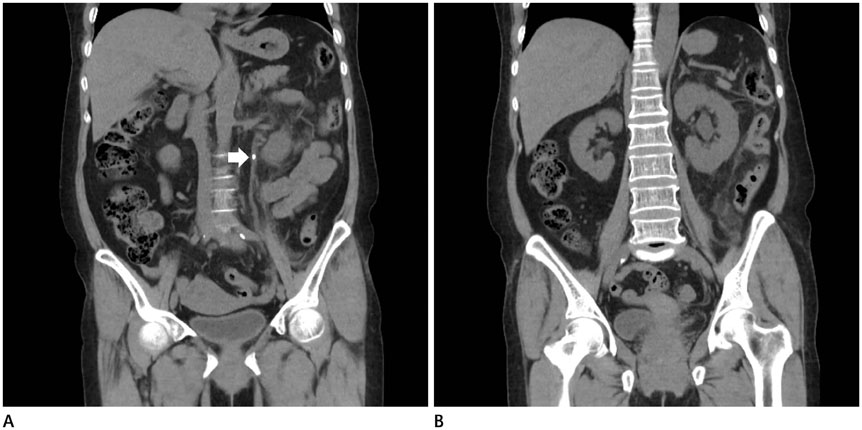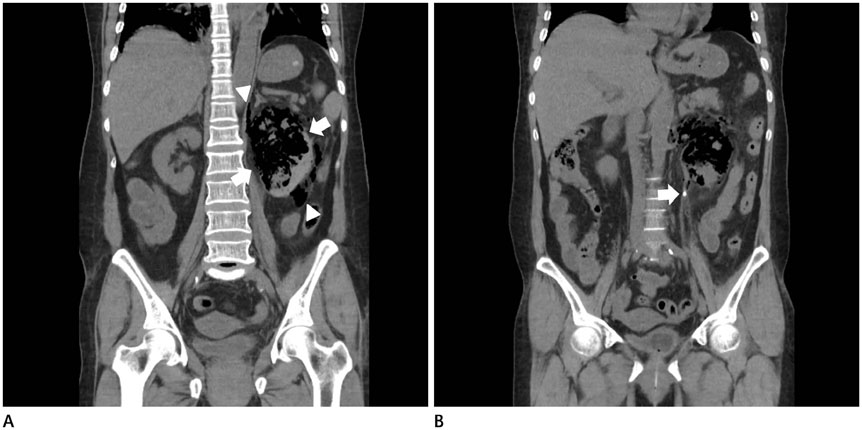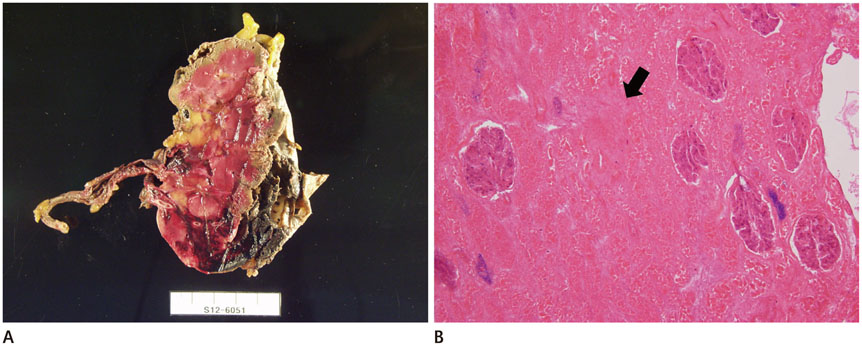J Korean Soc Radiol.
2015 Sep;73(3):204-208. 10.3348/jksr.2015.73.3.204.
Emphysematous Pyelonephritis: A Rare Life-Threatening Complication after Extracorporeal Shock Wave Lithotripsy
- Affiliations
-
- 1Department of Radiology, Yeouido St. Mary's Hospital, College of Medicine, The Catholic University of Korea, Seoul, Korea. bookdoo7@catholic.ac.kr
- 2Department of Urology, Yeouido St. Mary's Hospital, College of Medicine, The Catholic University of Korea, Seoul, Korea.
- KMID: 2043614
- DOI: http://doi.org/10.3348/jksr.2015.73.3.204
Abstract
- Emphysematous pyelonephritis (EPN), caused by extracorporeal shock wave lithotripsy (ESWL), has not been reported in the literature; and the mechanism of this disease is unknown. Although many studies have conjectured about the various causes of EPN, ESWL was not one of them. The patient in this report was a 65-year-old woman with a past medical history of diabetes; the patient underwent an ESWL that caused the EPN. To the best of our knowledge, this is the first report of an EPN case that was caused by ESWL.
Figure
Reference
-
1. Chaussy C, Brendel W, Schmiedt E. Extracorporeally induced destruction of kidney stones by shock waves. Lancet. 1980; 2:1265–1268.2. Maziak DE, Ralph-Edwards A, Deitel M, Wait J, Watt HJ, Marcuzzi A. Massive perirenal and intra-abdominal bleeding after shock-wave lithotripsy: case report. Can J Surg. 1994; 37:329–332.3. Rassweiler JJ, Knoll T, Köhrmann KU, McAteer JA, Lingeman JE, Cleveland RO, et al. Shock wave technology and application: an update. Eur Urol. 2011; 59:784–796.4. Skolarikos A, Alivizatos G, de la Rosette J. Extracorporeal shock wave lithotripsy 25 years later: complications and their prevention. Eur Urol. 2006; 50:981–990.5. Chen H, Kreider W, Brayman AA, Bailey MR, Matula TJ. Blood vessel deformations on microsecond time scales by ultrasonic cavitation. Phys Rev Lett. 2011; 106:034301.6. Zhong P, Zhou Y, Zhu S. Dynamics of bubble oscillation in constrained media and mechanisms of vessel rupture in SWL. Ultrasound Med Biol. 2001; 27:119–134.7. Huang JJ, Chen KW, Ruaan MK. Mixed acid fermentation of glucose as a mechanism of emphysematous urinary tract infection. J Urol. 1991; 146:148–151.8. Shokeir AA, El-Azab M, Mohsen T, El-Diasty T. Emphysematous pyelonephritis: a 15-year experience with 20 cases. Urology. 1997; 49:343–346.9. Wan YL, Lee TY, Bullard MJ, Tsai CC. Acute gas-producing bacterial renal infection: correlation between imaging findings and clinical outcome. Radiology. 1996; 198:433–438.10. Falagas ME, Alexiou VG, Giannopoulou KP, Siempos II. Risk factors for mortality in patients with emphysematous pyelonephritis: a meta-analysis. J Urol. 2007; 178(3 Pt 1):880–885.
- Full Text Links
- Actions
-
Cited
- CITED
-
- Close
- Share
- Similar articles
-
- Effects of Extracorporeal Shock Wave Lithortripsy Experimentally Induced Cholelithiasis and Organs in the Dog
- Clinical Experience of Extracorporeal Shock Wave Lithotripsy for Urinary Calculi
- A Case of Emphysematous Pyelonephritis
- A Case of Emphysematous Pyelonephritis
- Extracorporeal shock wave lithotripsy of lower caliceal stone




